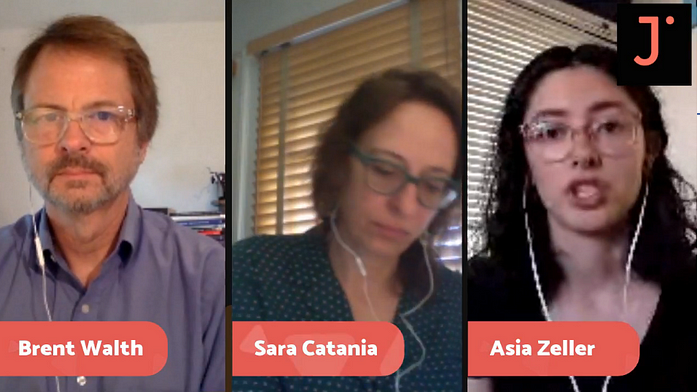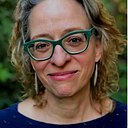
How do you spell solutions journalism? E-v-i-d-e-n-c-e
How a Pulitzer Prize-winning investigative journalist-turned professor overcame his skepticism and embraced rigorous reporting on responses to problems
TL;DR: To get right to Brent Walth’s list of 10 ways to know if it’s solutions journalism (from the Solutions Journalism Network), scroll to the bottom of this story.
If someone asked you to define solutions journalism, chances are “data,” “investigative” and “evidence” might not come to mind. Yet they top the list when Brent Walth teaches it.
Walth, a Pulitzer Prize-winning investigative journalist, first learned about solutions journalism in 2015, when he joined the faculty at the University of Oregon’s School of Journalism and Communication after more than 30 years as an editor and reporter.
“I was skeptical,” Walth said. “After so many years as an investigative reporter, I wasn’t sure what it was. I wasn’t sure I liked what it sounded like. I was worried that it was more advocacy.”
What Walth discovered, however, was an approach that can enrich investigative reporting and create a greater sense of accountability. Now, he teaches an investigative solutions journalism course, one of a battery of offerings available to University of Oregon students via The Catalyst Project, a teaching and research initiative funded in part by the Solutions Journalism Network.

“It’s one thing for watchdog investigative reporters to point out problems, but too often the stories stop right there,” Walth said. “Solutions stories do a really good job of describing problems and then move forward. So for us, it was a question of, one genre looks back, and then stops at the present moment. The other looks at the present moment and suggests what could the future be, and they seem to fit together.
“We teach this as this continuous idea of discovering problems, identifying them, and then, what’s essential to solutions journalism, is to find evidence-based responses to problems that either the reporter has discovered, or that a community clearly sees.”
Asia Alvarez Zeller a senior at UO and an intern at Eugene Weekly, was drawn to Walth’s class — her second solutions journalism course — because of what she saw as an appealing blend of deep reporting and hopefulness.
“Investigative journalism, I guess I’m drawn to it because it holds people accountable, it uncovers wrongdoing,” Alvarez Zeller said. “Once that’s said and done, it’s like, okay cool, we’re done. But solutions journalism tells us that there’s more work to be done. There are areas where people in the community are already seeing what’s going on and responding to that, and then we, as journalists, get to go out and report on their responses. So I think it’s a more holistic way to do reporting.”

A story Zeller co-reported with a classmate in Walth’s class on unequal penalties for special education students was recently published in Eugene Weekly. Walth provided the students with a data set from the state department of education that showed how often students are suspended or expelled from schools — data he’d already vetted for potential stories. UO is on a ten-week quarter system, and he didn’t want students wasting precious reporting hours chasing after stories that wouldn’t pan out.
“I already know that there’s something here to look at,” Walth said. “Sometimes they discover something else, but if students start to struggle, I can point them toward what I see as the story.”
In this case, the story was about glaring disparities in the way students with special needs were disciplined. Alvarez Zeller and her classmate also discovered a “positive outlier” — a district where the data suggested big improvements.
“Starting with data really helped, because we had really clear numbers of which district had the greatest disparity and which had the lowest, so we were able to say, oh that’s odd. Let’s go find out why,” Alvarez Zeller said. “We talked to the director about why their district is succeeding in this, and they didn’t have one specific thing, but they were able to say all the things that they do, and say that they were in fact aware that the discipline of these students is an issue and they are being proactive about it and here are all the reasons why and all the ways how.”
That experience, and the rigorous reporting the story required, deepened Alvarez Zeller’s commitment to the approach. “It has to have evidence that it’s working in some way,” she said. “It has to have insights. It has to be replicable in a different area. It has to also have limitations. You have to be transparent with your audience where it’s falling short.

“What really drew me to it was that I didn’t know a lot about journalism when I first took the course, and my idea of what journalism was was, oh, we have features and you have hard news, and hard news is really short and quick, and that wasn’t really something that interests me all that much,” she said. “But taking the solutions journalism course I was able to see, probably for the first time, what rigorous reporting could look like, and how it could be important.”
Another element that resonated with Alvarez Zeller were the conversations Walth’s course sparked about advocacy. “We talked a lot about advocacy, and whether solutions journalism was advocacy,” she said. “And so I think for the first time in my college career I had to think through the ethics of solutions journalism and my role as a journalist, and if what I would be doing is advocacy or if it’s objective or anything like that. It sparked a lot of new thoughts for me.”
The advocacy question is one that Walth has grappled with as well. “In my career as an investigative reporter, oftentimes we’d write the story and present the evidence and wait for someone else to step forward and say, here’s what can be done about it, whether it was the editorial board of the newspaper, or an elected leader,” he said. “And oftentimes that would not happen.”

But the journalistic mores of the day left little opportunity for further action on the part of Walth or his colleagues. “We often felt we were going to be seen as advocates, if we pushed the story too far toward responding to the problem,” he said. “But what’s been clear to me in recent years, and particularly now teaching at the University of Oregon, is that you can do that without being an advocate. You can do that by pursuing evidence, talking to people who have addressed the same problem in another community, and move it forward journalistically, as opposed to advocating for one outcome or another.”
On a practical level, Walth acknowledges that teaching an investigative solutions journalism course in the span of a quarter — or even a semester — can be daunting. He suggests investing in the first weeks in developing a thorough grounding in the basics of solutions journalism, getting the students out into the field to report as quickly as possible, and building in frequent, thorough status updates. “The key is lots of check-ins, what are they doing well, what’s working, what needs more work,” he said. “Oftentimes it’s giving the young journalist permission to be asking questions that they might not have thought they could ask. And that’s really the key.”

For Walth, the most gratifying aspect of teaching solutions journalism is helping equip the next generation of journalists with a “new and improved” approach to investigative reporting. “I’m really really fortunate to work with people who let me take the time and study it, and I would urge everyone to take the time, really understand what it’s about, what’s required, and how it can change the work of students,” he said. “For me it’s paid off wonderfully because I’m able to show students whole new experiences that I hadn’t been able to have in my own career.”
Here is Brent Walth’s 10-point solutions journalism checklist
(from the Solutions Journalism Network)


Sara Catania is director of journalism school partnerships for the Solutions Journalism Network and teaches journalism at USC Annenberg.
Join the Solutions Journalism Hub (it’s free!) for access to a trove of online resources for teaching solutions journalism, including the Curriculum Builder and the Solutions Story Tracker — a searchable database of more than 6,000 vetted solutions journalism stories from across the U.S. and around the world.

